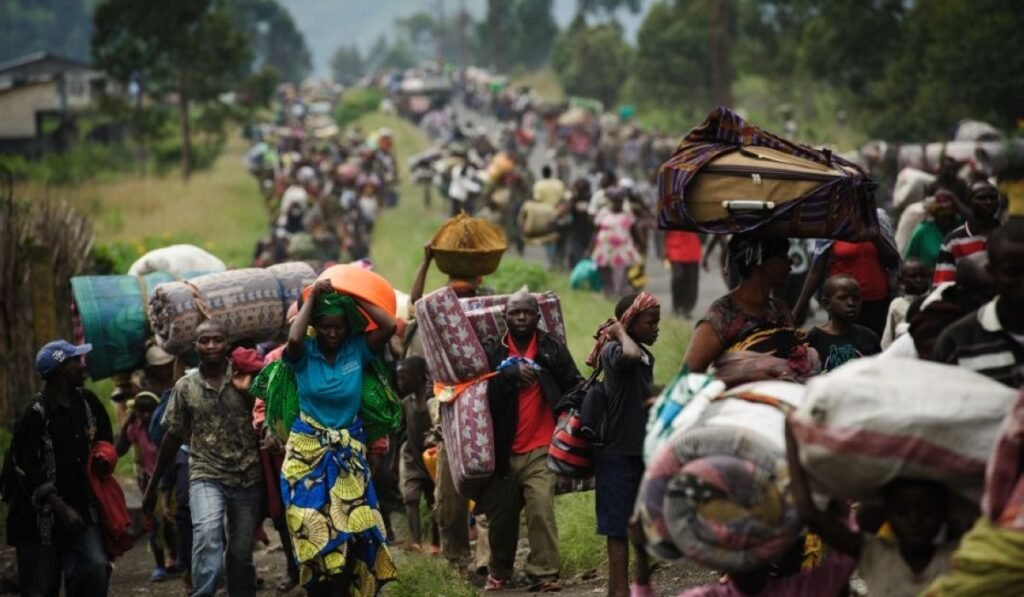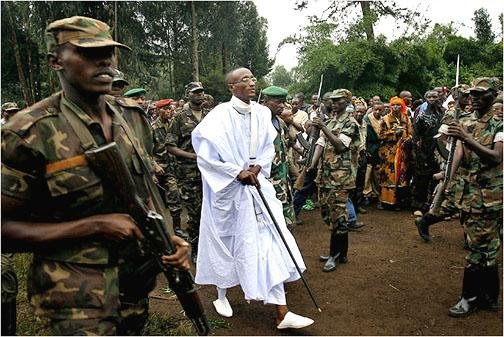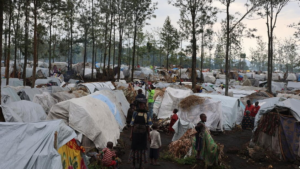Genocide. Just the word sends chills down our spines. It's one of humanity's darkest actions, a horrifying chapter in the story of any nation. Genocide is a harrowing and tragic event that leaves an indelible mark on the history of any nation. When we hear about genocides, we often think of places like Rwanda, but did you know that Congo has faced its own tragic episodes of mass violence? The causes of genocide in Congo are multifaceted and deeply rooted in the country's history, politics, and social dynamics.
In the case of the Democratic Republic of Congo (DRC), understanding the causes of genocide is vital to comprehend the underlying issues that have plagued the country for decades.
A Brief History of Conflict in Congo

To understand the causes of genocide in Congo, we need to take a step back and look at the country's tumultuous history. The Democratic Republic of Congo (DRC), formerly known as Zaire, has been plagued by violence for decades. Its troubles can be traced back to the colonial era, when King Leopold II of Belgium exploited the region for its rich resources, leading to widespread suffering and death among the local population.
Colonial Exploitation and Its Legacy
King Leopold's reign over the Congo Free State from 1885 to 1908 is one of the most brutal colonial regimes in history. Millions of Congolese died from forced labor, disease, and harsh punishments. The legacy of this exploitation laid the groundwork for future conflicts, as it left the region politically fragmented, economically devastated, and socially traumatized.
Independence and Political Instability
Congo gained independence from Belgium in 1960, but the transition was far from smooth. The country's first prime minister, Patrice Lumumba, was assassinated, leading to a power struggle that saw Joseph Mobutu seize control. Mobutu's authoritarian rule, characterized by corruption and repression, further destabilized the nation. His fall in 1997 marked the beginning of the First Congo War, which set the stage for subsequent genocides.
Ethnic Tensions and Rivalries
One of the primary causes of genocide in Congo is the deep-seated ethnic tensions and rivalries within the country. The DRC is home to over 200 ethnic groups, each with its own language, culture, and history. These diverse communities have often clashed over resources, political power, and land, leading to cycles of violence.
The Hutu-Tutsi Conflict
The spillover of the Rwandan Genocide into Congo is a significant factor in understanding the causes of genocide in Congo. After the 1994 genocide in Rwanda, where Hutu extremists killed hundreds of thousands of Tutsis and moderate Hutus, many perpetrators fled to Congo. This influx of refugees included armed groups that continued their violent campaigns, further destabilizing the region.
Inter-ethnic Violence
Beyond the Hutu-Tutsi conflict, Congo has experienced numerous other inter-ethnic clashes. For example, the Luba and Hemba tribes in the Katanga region have fought over land and resources, leading to brutal massacres. Similarly, in the Ituri region, the Hema and Lendu communities have engaged in prolonged conflicts, driven by competition over gold mines and political dominance.
Political Power Struggles

Political power struggles are another significant cause of genocide in Congo. The country's leadership has often been contested, leading to violent power grabs and uprisings.
The First and Second Congo Wars
The First Congo War (1996-1997) and the Second Congo War (1998-2003) were pivotal events that fueled genocidal violence. The First Congo War saw the overthrow of Mobutu by a coalition of Congolese rebels and neighboring countries, including Rwanda and Uganda. The power vacuum created by Mobutu's fall led to a scramble for control, igniting further conflicts.
The Second Congo War, also known as the Great African War, involved multiple African nations and resulted in millions of deaths, both from direct violence and from disease and starvation. This war was marked by widespread atrocities against civilians, including mass killings, rape, and the use of child soldiers.
Rebel Groups and Militia
Congo is rife with rebel groups and militias, each vying for control over territories rich in resources. Groups like the Democratic Forces for the Liberation of Rwanda (FDLR), the March 23 Movement (M23), and the Allied Democratic Forces (ADF) have committed numerous atrocities against civilians. These groups often use genocidal tactics to assert dominance and control over regions, further contributing to the cycle of violence.
Economic Exploitation and Resource Wars
The DRC is incredibly rich in natural resources, including diamonds, gold, coltan, and cobalt. Paradoxically, this wealth has been a curse rather than a blessing, fueling conflict and genocidal violence.
Resource Plunder by Foreign Interests
Foreign corporations and neighboring countries have long exploited Congo's resources, often with little regard for the local population. This exploitation has funded armed groups and corrupt officials, perpetuating violence and instability. For instance, Rwanda and Uganda have been accused of smuggling minerals from Congo to finance their own economies and military operations.
Local Armed Groups and Resource Control
Locally, armed groups fight for control over resource-rich areas, using the proceeds to fund their activities. The competition for these lucrative resources often leads to brutal tactics, including massacres, forced displacement, and systematic rape. The term "conflict minerals" has become synonymous with Congo's bloody struggle over its natural wealth.
Weak Governance and Corruption
A weak and corrupt government is another critical factor in the causes of genocide in Congo. The DRC's government has often been unable or unwilling to protect its citizens, maintain law and order, or provide basic services.
Failure to Enforce Law and Order
The inability of the Congolese government to enforce law and order has allowed armed groups to operate with impunity. The lack of a strong, effective police force and judiciary means that crimes often go unpunished, creating a culture of violence and retribution.
Corruption and Mismanagement
Corruption is rampant in Congo, with government officials often embezzling funds meant for public services or the military. This corruption weakens the state's ability to respond to crises and maintain stability. It also means that resources meant for development and security are siphoned off, leaving communities impoverished and vulnerable to exploitation by armed groups.
International Involvement and Neglect
The international community's involvement in Congo has been a double-edged sword. While there have been efforts to bring peace and stability, there has also been neglect and complicity in the violence.
International Aid and Peacekeeping
International aid and peacekeeping missions have had mixed results in Congo. The United Nations Organization Stabilization Mission in the Democratic Republic of the Congo (MONUSCO) has been present for years, but its impact has been limited. While it has provided some protection and humanitarian assistance, it has also faced criticism for failing to prevent atrocities and for instances of misconduct by peacekeepers.
Complicity in Resource Exploitation
Some international actors have been complicit in the exploitation of Congo's resources, indirectly fueling the conflict. Global demand for minerals like coltan, used in electronics, has driven illegal mining and smuggling operations, benefiting armed groups and corrupt officials. The international community's failure to effectively regulate these supply chains has contributed to the ongoing violence.
Places Affected by Genocidal Violence in Congo
The causes of genocide in Congo have led to horrific violence across various regions. Some of the most affected areas include:
North Kivu
North Kivu, located in eastern Congo, has been a hotspot of violence due to its strategic location and rich resources. Armed groups like the FDLR and M23 have committed numerous atrocities against civilians in this region.
South Kivu
South Kivu, adjacent to North Kivu, has also experienced significant violence. The region is home to various armed groups, and the local population has suffered from massacres, sexual violence, and forced displacement.
Ituri
The Ituri region in northeastern Congo has been the site of brutal ethnic clashes between the Hema and Lendu communities. These conflicts have resulted in thousands of deaths and the displacement of hundreds of thousands of people.
Katanga
Katanga, in southern Congo, has seen violent conflicts between the Luba and Hemba tribes, primarily over control of land and resources. The region has also been affected by the activities of various armed groups and militias.
Conclusion
The causes of genocide in Congo are complex and deeply rooted in the country's history, ethnic dynamics, political struggles, and economic exploitation. Understanding these causes is crucial for addressing the violence and working toward a more peaceful future. By shedding light on these issues, we can hope to bring about change and support the people of Congo in their quest for peace and stability.
Frequently Asked Questions
1. Why has Congo experienced so much violence?
Congo's violence stems from a combination of ethnic tensions, political power struggles, economic exploitation, weak governance, and international involvement. The interplay of these factors has created a volatile environment where genocidal violence can occur.
2. What role do natural resources play in Congo's conflicts?
Natural resources are a significant driver of conflict in Congo. Armed groups and corrupt officials exploit these resources to fund their activities, leading to violence and instability. The competition for control over resource-rich areas often results in brutal tactics, including massacres and forced displacement.
3. How has the international community responded to the violence in Congo?
The international community has responded with aid and peacekeeping missions, but the impact has been limited. While efforts like MONUSCO have provided some protection and assistance, they have also faced criticism for their ineffectiveness and instances of misconduct. Additionally, international demand for Congo's resources has indirectly fueled the conflict.
4. Can the violence in Congo be stopped?
Ending the violence in Congo is challenging but not impossible. It requires a multifaceted approach that addresses the root causes, including ethnic tensions, political instability, economic exploitation, and weak governance. Strengthening the Congolese state, promoting reconciliation, and regulating resource supply chains are essential steps toward peace.
5. How can I help the people of Congo?
You can help by supporting organizations that provide humanitarian aid and advocate for peace in Congo. Raising awareness about the situation and advocating for responsible sourcing of conflict-free minerals can also make a difference. Every effort counts in bringing attention and aid to those suffering from the violence.
6. What are the main causes of genocide in Congo? A: The main causes of genocide in Congo include ethnic tensions, resource exploitation, political instability, corruption, and the presence of armed groups.
7. How has resource exploitation contributed to genocide in Congo? A: Resource exploitation has fueled conflict by creating competition for valuable minerals, funding armed groups, and attracting foreign actors who prioritize profit over the well-being of local populations.
8. What role do ethnic tensions play in the causes of genocide in Congo? A: Ethnic tensions, exacerbated by historical grievances and colonial favoritism, have led to violent clashes and massacres as different groups vie for control and resources.
9. How has political instability contributed to the causes of genocide in Congo? A: Political instability, characterized by weak governance, corruption, and power struggles, has created an environment where violence and impunity thrive, undermining efforts to build a stable nation.
10. What efforts have been made to address the causes of genocide in Congo? A: Efforts to address the causes of genocide in Congo include international peacekeeping missions, humanitarian aid, and grassroots initiatives focused on peacebuilding, reconciliation, and supporting survivors.
11. What impact has the violence had on civilians in Congo? A: The violence has resulted in mass killings, sexual violence, forced displacement, and a severe humanitarian crisis, with millions of people living in overcrowded and under-resourced refugee camps.
12. How can the international community help address the causes of genocide in Congo? A: The international community can help by providing support for peacekeeping missions, delivering humanitarian aid, promoting accountability and good governance, and supporting local initiatives aimed at peace and reconciliation.


